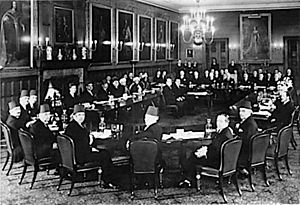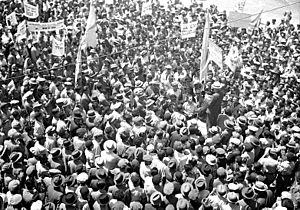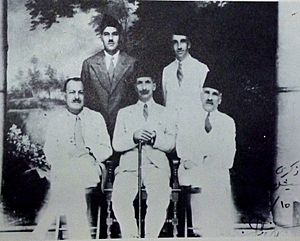London Conference of 1939 facts for kids
The London Conference of 1939 was an important meeting held by the British government to decide what would happen to Palestine. It took place at St James's Palace in London from February 7 to March 17, 1939. The main goal was to find a way for Palestine to govern itself and to end the British "Mandate" (their control over the area).

Because the Arab and Jewish groups refused to meet together, the British Colonial Secretary, Malcolm MacDonald, had to hold separate discussions with each side. MacDonald had warned that if they couldn't agree, Britain would simply make its own decision. After about five and a half weeks, the conference ended without an agreement. The British then announced their own plans, which became known as the 1939 White Paper.
Contents
Why the Conference Happened
In 1936, there was a big uprising in Palestine called the Great Arab Revolt. Arabs in Palestine went on a general strike, and their leaders formed a group called the Higher National Committee (HNC).
After the strike, the British government sent a group called the Peel Commission to investigate the reasons for the unrest. This commission was led by Lord Peel. Their job was to suggest solutions, keeping in mind Britain's promise to create a homeland for the Jewish people in Palestine, made in the Balfour Declaration.
The Peel Commission suggested dividing Palestine into two parts: one for Jews and one for Arabs. Important Jewish leaders like Chaim Weizmann and David Ben-Gurion convinced the World Zionist Congress to consider this idea as a starting point for talks.
However, the Arabs completely rejected the idea of dividing the land. Violence increased after the Peel Commission's report was published. The British government then banned the HNC and other Arab nationalist groups. Some Palestinian leaders were sent away, and others, like Haj Amin Husseini, went into hiding or left the country.
During 1938, fighting between Arabs and the British, and between Arabs and Jews, got much worse. Arab fighters took control of many rural areas and some towns, including the Old City of Jerusalem. Jewish underground groups also set off bombs in Arab markets. The British sent more troops and declared martial law (military rule).
Another commission, the Woodhead Commission, was sent in 1938 to figure out how to divide the land. Palestinian Arabs boycotted this commission because their leaders were exiled or in hiding. The Woodhead Commission looked at different plans but decided that the Peel plan couldn't work without forcing many Arabs to move, which the British government did not want to do.
So, the British government announced that dividing Palestine was not practical. They also said they wanted to end their control (the Mandate) over Palestine and would continue to govern until a new system was in place. To discuss this, Colonial Secretary Malcolm MacDonald invited Arab and Jewish delegations to London. He made it clear that if they couldn't agree, Britain would impose its own solution.
The Arab delegation included Palestinians and representatives from five Arab countries friendly to Britain. The Jewish delegation was chosen by the Jewish Agency and included Jews from around the world, as well as from Palestine.
By late 1938, Britain was very worried about Nazi Germany expanding in Europe. If World War II started, Britain needed to keep control of Egypt, Iraq, and Palestine. This meant they would likely offer more to the Arabs, which would disappoint the Zionists (supporters of a Jewish homeland).
Getting Ready for the Conference
Some Palestinian leaders liked the idea of the conference. It became clear that the British would have to deal with the Higher National Committee (HNC) and former Mufti of Jerusalem Amin Husseini, even though they had been banned.
On November 23, Malcolm MacDonald said he still wouldn't let Amin Husseini be a delegate. However, he agreed to let five Palestinian leaders who had been sent away to the Seychelles islands attend. This was part of a deal to make sure Palestinian Arabs would be at the conference. MacDonald also promised that the British Mandate would be replaced by a treaty. The exiled leaders were released and traveled to Cairo and Beirut, where a new Higher National Committee was formed. Amin Husseini, though not officially a member, still guided the delegation. This is why they refused to include delegates from the National Defence Party (NDP), a more moderate Palestinian group. Later, two NDP delegates were added after the conference began.
The five Arab countries invited were Egypt, Iraq, Saudi Arabia, Yemen, and Transjordan. All of these were under British influence. Egypt, Iraq, and Saudi Arabia had helped end the 1936 strike.
The Zionists were not happy about the conference and debated whether to attend. Their group was led by Chaim Weizmann from the Jewish Agency. To show they represented all Jews, their delegation included members from the US, Europe, Britain, South Africa, and Palestine.
The conference officially began on February 7, 1939, at St James's Palace in London. The Prime Minister, Neville Chamberlain, opened it. Because the Arab delegation refused to meet with the Jewish Agency delegation, there were two separate opening ceremonies.
Meetings with the Arab Delegation
The Arab delegation was led by Jamal Husseini. Other members included Awni Abd al-Hadi, Yacoub Al Ghussein, Husayin al-Khalidi, Alfred Roch, and Musa Alami. They were joined by secretaries George Antonius and Fu'ad Saba. Representatives from Arab countries also attended, such as Aly Maher from Egypt and Prime Minister Nuri Said from Iraq. Saudi Arabia was represented by Prince Faisal and Prince Khalid, who both later became kings.
The Palestinian delegates had met with other Arab state representatives in Cairo before the conference. Despite pressure, the Palestinian group refused to include members from the moderate National Defence Party (NDP). There was violence between Arab rebels and NDP supporters, causing many deaths in 1939. The NDP claimed to represent many upper-class Palestinians and demanded to be at the conference. The British hinted that if no agreement was reached, they would talk to two separate Palestinian Arab groups. So, Raghib al-Nashashibi and his deputy joined the Arab delegation two days after the conference started.
Even though the main Arab delegates refused to meet with the Jewish Agency, some informal meetings happened with other Arab delegates.
On February 9, Jamal Husseini presented the Arab demands:
- Full independence for Palestine.
- No Jewish national home in Palestine.
- The British Mandate should be replaced by a treaty.
- An end to Jewish immigration into Palestine.
One of the first things the conference tried to do was understand old letters written in Arabic between the British government and the governor of Mecca, Hussein bin Ali, from 1915-1916. These letters, known as the McMahon-Hussein Correspondence, encouraged Hussein to start the Arab Revolt against the Ottoman Empire. A British-Arab committee was formed to study them. They found that the Arab point of view had been downplayed. However, the two sides couldn't agree on whether Palestine was included in the areas promised to the Arabs.
Another idea discussed was making a Jewish area (canton) as part of a larger Syria. But both sides quickly rejected this idea.
On March 17, after warning the delegation, MacDonald read a statement outlining the British proposals and closed the conference. There had been 14 meetings between the British and the Arabs. The British proposals were later published as the 1939 White Paper.
Meetings with the Jewish Agency Delegation
The Jewish Agency delegation was led by Chaim Weizmann, who was the chairman of the World Zionist Organization. However, David Ben-Gurion, the leader of the Jewish Agency, had the most influence on decisions. Ben-Gurion insisted that the delegation represent the Jewish Agency, not just "the Jews." To show they represented all Jews, the delegation included non-Zionists and members from various countries.
Other important members of the delegation included Moshe Sharett, Leonard Stein, and Berl Katznelson.
This conference showed Ben-Gurion becoming the main decision-maker for Zionist policy. It also marked a shift in his thinking towards what he called "combative Zionism." He believed that the Yishuv (the Jewish community in Palestine) was strong enough to defend itself. Out of 440,000 Jews, about 45,000 were armed. His main goal was to continue and increase Jewish immigration, especially for young people of military age.
After the opening ceremony, MacDonald chaired the meetings. Weizmann presented the Jewish Agency's position, which focused on four main points:
- Jews in Palestine should not be treated as a minority.
- The British Mandate should continue.
- Jewish immigration should continue, based on how many people the country could support.
- Investment was needed to speed up development in Palestine.
The delegation was willing to accept the idea of dividing the country, as suggested by the Peel Commission, even though they had some objections. Weizmann and Ben-Gurion had convinced the World Zionist Congress to approve the Peel recommendations as a basis for talks.
Despite the Palestinian Arab boycott, some meetings did happen with other Arabs. On the evening of March 7, the British managed to arrange an informal meeting between three Arab delegates and four Jewish delegates, along with MacDonald and other British officials. The Egyptian delegate, Aly Maher, asked for less Jewish immigration and an end to the violence. Weizmann suggested they might find common ground, but Ben-Gurion interrupted, saying there could be no reduction in immigration. The meeting ended quickly.
It was hard to keep the details of these private meetings secret. At one point, the Jewish Agency was upset by reports of a comment MacDonald made to the Arab delegation, which they felt was anti-Semitic (prejudiced against Jews).
At a meeting on February 24, 1939, Ben-Gurion stated the Jewish Agency's minimum demands: the Mandate must continue, and nothing should suggest Jews were a minority. MacDonald then outlined the British policy: after a transition period, Palestine would become an independent state allied with Britain, and the Jewish minority would have protected status. On February 26, both delegations received a written summary of these plans. That evening, the Jewish Agency refused to attend a dinner held in their honor. The next day, a Jewish newspaper in Palestine published a message from Ben-Gurion saying, "There is a scheme afoot to liquidate the National Home and turn us over to the rule of gang leaders." On the same day, a series of bombs across Palestine killed 38 Arabs. The Jewish delegation then refused to hold any more formal meetings and only met informally in MacDonald's office.
On March 17, Weizmann sent a letter to MacDonald stating, "The Jewish delegation... regrets that it is unable to accept them as a basis for agreement, and has therefore decided to disband."
What Happened Next
Two days before the conference ended, the German Army took over the rest of Czechoslovakia.
MacDonald's final proposals, published on May 17, 1939, included:
- A limit on Jewish immigration for five years. After that, numbers would be decided with the Palestinian Arabs.
- Restrictions on Jews buying land.
- Gradual introduction of Palestinians (both Jews and Arabs) into important government jobs.
- Transfer of all power to a representative government after ten years.
These proposals depended on the violence in Palestine ending. If, after ten years, no agreement was reached on the form of government, the British would rethink the situation.
After the delegations left London, the British tried again to get Arab approval. They suggested a faster transfer of power if the violence stopped. However, in May, the HNC delegation announced they rejected the White Paper. Amin Husseini forced this decision, even though most delegates wanted to accept it. Some believe he had to refuse to deal with the British to keep his leadership among the rebels in Palestine.

On April 17, a Jewish labor organization called the Histadrut announced a campaign against the proposals. In the first month after the conference, over 1,700 Jewish illegal immigrants entered Palestine. On May 17, when the White Paper was published, telephone lines were cut, and government offices were attacked. Riots broke out in Jerusalem, and Jewish attacks on Arabs and government property continued through the summer. A Jewish underground group, the Etzel, claimed to have killed over 130 people during that time. There was also a rise in illegal immigration, leading to more Jewish unemployment.
In Zionist groups, Herbert Samuel was blamed for some of the ideas in the White Paper.
Ben-Gurion wrote in his diary, "This is not the last word." He later said that Prime Minister Neville Chamberlain had told him the policy would not last beyond the war.
Sources
- A Survey of Palestine - prepared in December 1945 and January 1946 for the information of the Anglo-American Committee of Inquiry. Reprinted 1991 by The Institute of Palestine Studies, Washington. Volume one: ISBN: 0-88728-211-3.
- Abcarius, M.F. (nd) Palestine. Through the Fog of Propaganda. Hutchinson.
- Antonius, George (1938) The Arab Awakening. The Story of the Arab National Movement. Hamish Hamilton. (1945 edition)
- Nevill Barbour Nisi Dominus - A Survey of the Palestine Controversy. First published 1946. The Institute for Palestine Studies, Beirut 1969. Reprint series No. 3.
- Bar-Zohar, Michael (1978) Ben-Gurion. Translated by Peretz Kidron. Weidenfeld & Nicolson, London. ISBN: 0-297-77401-8. Originally published in Israel 1977. p. 94
- Cohen, Aharon (1970) Israel and the Arab World. W.H. Allen. ISBN: 0 491 00003 0.
- Israel Pocket Library (1973) History From 1880. Ketter Books, Jerusalem.
- Kayyali, Abdul-Wahhab Said (1981) Palestine. A Modern History Croom Helm. ISBN: 086199-007-2.
- Khalidi, Walid (1984) Before their Diaspora: A photographic history of the Palestinians, 1876-1948. Institute of Palestine Studies. ISBN: 0-88728-143-5.
- Marlowe, John (1946) Rebellion in Palestine. The Cresset Press, London.
- Segev, Tom (2000) One Palestine, Complete - Jews and Arabs under the British Mandate. Little, Brown & Co. ISBN: 0-316-64859-0.
- Teveth, Shabtai (1987) Ben-Gurion. The Burning Ground. 1886-1948. Houghton Mifflin. ISBN: 0-395-35409-9.
- Weizmann, Chaim (1949) Trial and Error. Hamish Hamilton. (2nd edition. April 1949).


